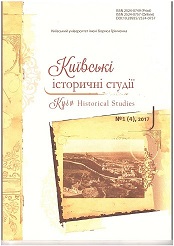FORMATION OF THE CULTURAL CENTER IN GRINVICH VILLAGE IN 19 — EARLY 20 CENTURIES
DOI:
https://doi.org/10.28925/2524-0754.2017.1.1925Keywords:
Greenwich Village, culture, New York bohemiaAbstract
The article focuses on the formation process of cultural centre in the area of Greenwich Village in New York and life of New York bohemians. Research followed the process of formation of the settlement of Greenwich and its transformation into the New York City area after its affiliation by the city. During the research it is raised the questions of social and economic conditions of the resettlement of writers and artists in the neighborhood and their living conditions and social interaction between themselves. In the process of exploring the prerequisites for the formation of Cultural Center in Greenwich Village was also considered social and ethnic heterogeneity in the neighborhood and its division into zones, each of which corresponded to certain ethnic or social groups. It was determined the existence of the phenomenon of Greenwich Village as a “city in the city” caused by isolation of the area from the rest of the New York from the earliest period of Village history. By the 1830s it was the territorial delimitation and after — a purely imaginary in people’s minds. It is defined three main reasons for the transformation of the Greenwich Village into a cultural centre: its isolation from the rest of the city, low rent prices and the crisis of universities, which forced young intellectuals to settle outside of it.
Downloads
References
Alanson Skinner The Indians of Manhattan Island and Vicinity. — Paderborn : SalzwasserVerlag GmbH, 2012. — 68 p.
Bayrd Still, Joseph J. Roberto Greenwich Village. A brief architectural and historical guide with illustrations and a walking tour map. — New York : New York University, 1975. — 36 p.
Caroline F. Ware Greenwich Village 1920–1930. A comment on American civilization in the post-war years. — New York: Harper & Row, 1935. — 464 p.
Charles M. Oliver Critical Companion to Walt Whitman: A Literary Reference to His Life and Work. — New York : Facts on File, 2006. — 408 p.
Douglas Hunter Half Moon: Henry Hudson and the Voyage that Redrew the Map of the New World. — New York — Berlin — London, 2009. — 336 p.
Elizabeth Bisland Old Greenwich // Historic New York during two centuries. — New York and London : The Knickerbocker Press, 1897. — 26 p.
Evoking the World of Winslow Homer // The New York Times [Електронний ресурс]. — August, 17. — New York, 1997. — Режим доступу : http://www.nytimes.com/1997/08/17/realestate/evoking-theworld-of-winslow-homer.html
Greenwich Village Historic District Designation Report. — Vol. 1. — New York, 1969. — 398 p.
Greenwich Village Historic District Extension II Designation Report. — New York, 2010. — 376 p.
Greenwich Village in Poetry. Showing the Village as it really was and as is actually is / Edited by C. Grand Pierre. — New York, 1923. — 36 p.
Guido Bruno Among Our Aristocrats // Bruno’s Weekly. — December, 18. — New York, 1915. — 30 p.
Henry Adams The Education of Henry Adams: An Autobiography (With an introduction by Donald Hall). — Boston — New York : A Mariner Book, 2000. — 544 p.
I. N. Phelps Stokes The Iconography of Manhattan Island, 1498–1909: compiled from original sources and illustrated by photo-intaglio reproductions of important maps, plans, views, and documents in public and private collections. — Vol. III. — New York : Robert H. Dodd, 1915. — 962 p.
I. N. Phelps Stokes The Iconography of Manhattan Island, 1498–1909: compiled from original sources and illustrated by photo-intaglio reproductions of important maps, plans, views, and documents in public and private collections. — Vol. II. — New York : Robert H. Dodd, 1915. — 874 p.
I. N. Phelps Stokes The Iconography of Manhattan Island, 1498–1909: compiled from original sources and illustrated by photo-intaglio reproductions of important maps, plans, views, and documents in public and private collections. — Vol. VI. — New York : Robert H. Dodd, 1915. — 908 p.
New York is Enough for Him // The Sun. — July 23, 1893. — 10 p.
Notable American Women: A biographical dictionary, 1607–1950 / Edited by Edward T. James, Janet Wilson James, Paul S. Boyer. — Cambridge : Belknap Press, 1971. — 686 p.
Obituary // The Sun. — May 21, 1893. — 28 p.
Ronald G. Pisano The Tile Club and The Aesthetic Movement in America. — New York : The museums at Stoney Brook, 1999. — 112 p.
Ross Wetzsteon Republic of Dreams Greenwich Village: The American Bohemia, 1910–1960. — New York : Simon and Schuster, 2002. — 582 p.
Steven Beal Independent Intellectuals in the US. 1910–1945. — New York and London : New York University Press, 1995. — 310 p.
The Bohemians and Thief Host // New York Herald. — March 20, 1869. — 12 p.
Published
How to Cite
Issue
Section
License
Copyright (c) 2017 Kyiv Historical Studies

This work is licensed under a Creative Commons Attribution-NonCommercial-ShareAlike 4.0 International License.
Authors who publish in this journal retain the right of authorship of the work and give to the journal right of first publication of this work under the conditions of Creative Commons: Attribution-NonCommercial-ShareAlike 4.0 International (CC BY-NC-SA 4.0), which allows others freely distribute the work published with reference to the authors of the original work and the first publication of this magazine.














